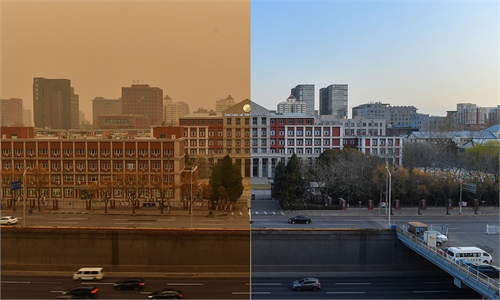After a dusty spring, China seeks further cooperation on sand control with Mongolia
This spring, many parts of northern China, including the capital Beijing, have been consistently invaded by sand and dust from Mongolia. The two neighboring countries have been sharing projects for controlling the sand in recent decades, but the dreadful sandstorms that have affected China have caused more calls for cooperation to deal with the problem.

After being enveloped by sand and dust for a whole day on March 15 in the largest sandstorm in a decade, Beijing has cleared up and the yellow warning for sandstorms was lifted the following day, with the city a picture of blue skies and sunshine. Photo: Li Hao/GT
A once-in-a-decade, massive sandstorm hit northern China on March 15, turning the air yellow and covering vehicles or anything in the open air with dust. The AQI index in Beijing surpassed 8,000, a record number, and the sandstorm is estimated to have killed at least 10 people in Mongolia.
After that, northern China was hit by several more sandstorms. On Wednesday, Beijing and nearby regions suffered another sandstorm, leading to medium or heavy air pollution, media reports said.
In response to the situation, some Chinese scientists have proposed solutions. Researchers from the Institute of Desertification Studies under the Chinese Academy of Forestry have appealed for more work in monitoring the desertification of the Mongolian Plateau using remote-sensing techniques. They have also provided descriptions of the potential harm based on their research, the Global Times has learned.
“This dust storm shows that there's much to be done in regional cooperation to improve the environment,” Zhao Lijian, spokesperson for the Chinese foreign ministry, said on March 16. “We stand ready to join hands with neighboring countries and the international community to do a better job in improving and protecting the regional and global environment and to contribute to the building of a more beautiful and cleaner world.”
China and Mongolia share a border of more than 4,000 kilometers and Beijing is only 1,166 kilometers away from Ulan Bator, the capital of Mongolia, which is also home to half of Mongolia’s population. The ecological systems of the two countries are closely connected.
China and Mongolia have always cooperated in managing sand and dust, but China could also aid Mongolia with experience and technology. Every year, funding from national departments and the United Nations Convention to Combat Desertification is applied for this work, the Global Times learned from the Chinese Academy of Forestry.
Cao Xiaoming, a research fellow at the Institute of Desertification Studies under the Chinese Academy of Forestry, monitored the drought conditions in the Mongolian Plateau from 2011 to 2018 with remote-sensing techniques, together with scientists in Mongolia.
They found how climate change and human activities have led to dryer earth and desertification in the region, which covers both Mongolia and China’s Inner Mongolia.
According to Cao, the research is funded by the Chinese side. The results of the research are shared with Mongolian institutes.
From engagement with Mongolian scientists related to desertification, Cao found that they are also very concerned about the situation in Mongolia and that they cooperate and communicate with their Chinese colleagues.
As early as in 2002, China, Japan and South Korea, together with Mongolia launched joint research in the desert in southeastern Mongolia. In 2015, China, Russia and Mongolia signed an outline for building an economic corridor, in which enhancing ecological and environmental protection was underlined.
In 2011 and 2013, the former State Forestry Administration hosted training for sand control technologies and desertification prevention. For instance, in the 2013 training, 10 Mongolian experts and senior officials related to desertification prevention work visited China and had field trips in regions such as North China’s Inner Mongolia Autonomous Region.
The Mongolian participants learned about China’s successful cases in tackling desertification, from building haloxylon ammodendron forests, restoring vegetation and developing a carbon market, according to a statement sent from the Chinese Academy of Forestry.
However, sometimes the knowledge cannot be transferred into practical actions in Mongolia, said an employee at the forestry administration of Inner Mongolia, which participated in organizing the training.
Moreover, the current international cooperation is just a drop in the bucket in terms of changing the situation. Data shows that 76.8 percent of the earth in Mongolia suffered desertification in 2018, local media reports said.
“Smog and sandstorms usually hang over the sky of Ulan Bator in winter from September to March, which is annoying,” Yang Yupei, a construction project manager from a Chinese engineering company told the Global Times. “I think the Mongolian government should attach more importance to environmental protection,” Yang said.





